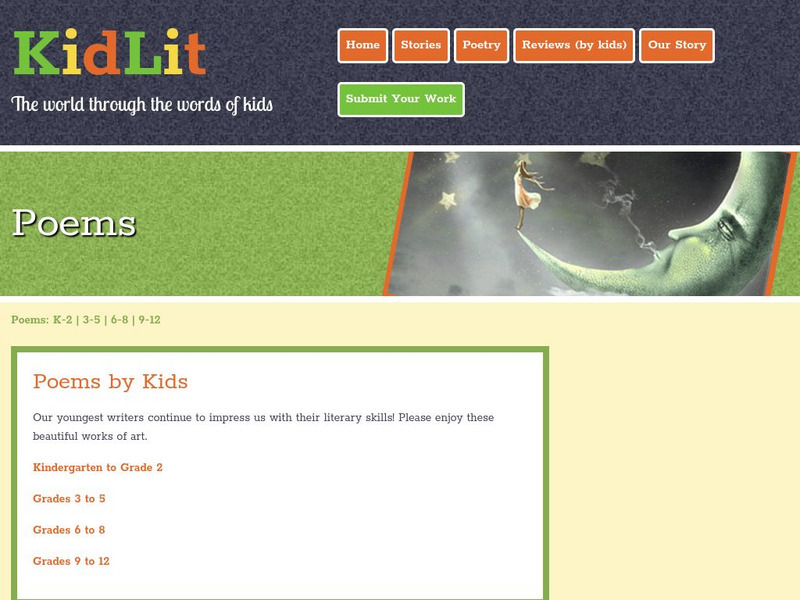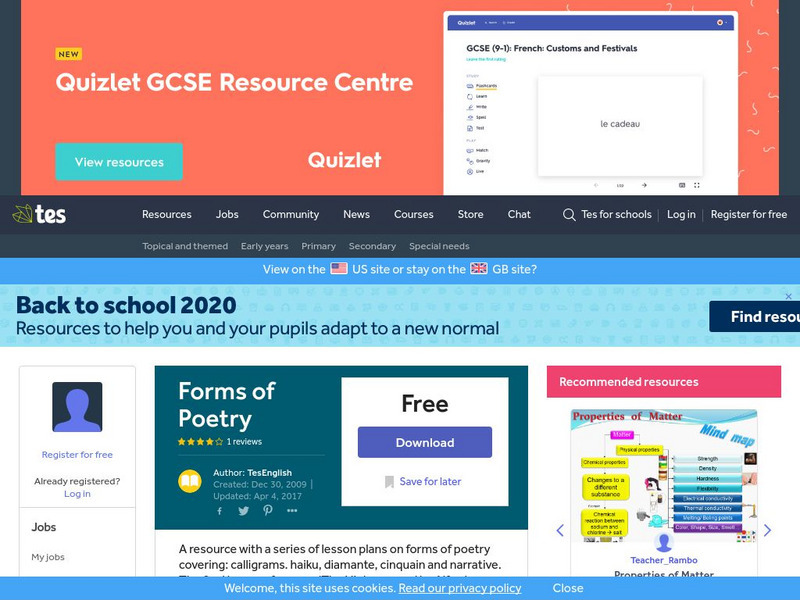Sonnet Central
Sonnet Central
A comprehensive site dedicated to the English sonnet. Site includes numerous pages grouped by country of origin and historic period. Also included is literary criticism of various sonnets and advice on how to write a sonnet. Click on the...
Other
Middle school.net: Shakespeare Analysis & Slide Show
Check out this informative site featuring an analysis of Shakespeare. The objective of this activity is for students to analyze a sonnet and present their findings via slide show. This lesson integrates technology into the curriculum.
Other
Petrarch and Laura: Peter Sadlon: How to Write a Sonnet [Pdf]
This is an 8-page PDF article on "How to Write a Sonnet" by Peter Sadlon. It provides background information about sonnets, discusses the two main kinds of sonnet Italian or Petrarchan form and English or Shakespearean form. It explains...
Emory University
Emory University: The Limerick
This site gives a good description of limerick. Features details about the rhyme scheme and the different forms of limericks. References to the bawdy nature of this verse form.
University of Toronto (Canada)
University of Toronto: Representative Poetry Online
A glossary of literary terms, primarily dealing with poetry, with definitions.
ReadWriteThink
Read Write Think: Found Poems/parallel Poems
Learners compose found and parallel poems based on a descriptive passage they have chosen from a piece of literature they are reading.
ReadWriteThink
Read Write Think: Lonely as a Cloud: Using Poetry to Understand Similes
Students identify similes in poetry and gain experience in using similes as a poetic device in their own work.
ReadWriteThink
Read Write Think: In the Poet's Shoes: Performing Poetry and Building Meaning
Build a greater understanding of poetry and poet's voice. Develop and interpret a poem for a oral performance. Links include presentation rubrics and participation rubric.
ReadWriteThink
Read Write Think: Poetic Form and Structure
This online lesson makes use of concrete poems to teach the structure and form of poetry. Uses a "Columbus Day," theme for the lesson, but can be used any time of the year.
ReadWriteThink
Read Write Think: Strategy to Define: Identify Poetic Terms
Online lesson plan offers teachers the ability to teach a "Four-square," strategy technique for poetic terms. Middle schoolers explore websites and define terms such as alliteration, assonance, simile, and rhyme.
University of Victoria (Canada)
The U Vic Writer's Guide: Literary Term: Ballad
The University of Victoria's English department gives a comprehensive definition of the "ballad" poetic form. Short examples included.
University of Victoria (Canada)
The U Vic Writer's Guide: Literary Term: Elegy
The University of Victoria's English department gives a comprehensive definition of the "elegy" poetic form. Example included.
University of Victoria (Canada)
The U Vic Writer's Guide: Literary Term: Epics
The University of Victoria's English department gives a comprehensive definition of the "epic" poetic form. Short examples included.
University of Victoria (Canada)
The U Vic Writer's Guide: Literary Term: Free Verse
A concise and thorough explanation of the term "free verse" in poetry. Provides a definition, differentiation from "blank verse," and an example from Walt Whitman.
University of Victoria (Canada)
The U Vic Writer's Guide: Literary Term: Ode
The University of Victoria's English department gives a comprehensive definition of the "ode" poetic form. Short examples included.
University of Victoria (Canada)
The U Vic Writer's Guide: Literary Term: Sonnet
The University of Victoria's English department gives a comprehensive definition of the "sonnet" poetic form.
University of Oregon
Pizzaz, Creative Writing & Storytelling: Bi Directional Spiraled Poems
This PIZZAZ (People Interested in Zippy and ZAny Zcribbling) lesson plan will engage middle schoolers in writing twist poems. Examples of ideas for these types of poems are provided. Variations of twist poems are listed as a way to...
PBS
Pbs: Language Arts: Lesson Plans: Language Arts: Shakespeare's Sonnets
The purpose of this lesson is to help young scholars cope with unfamiliar language in Shakespeare's sonnets and to help them understand and appreciate both what he says and how he says it.
Houghton Mifflin Harcourt
Holt, Rinehart and Winston: Elements of Literature: Poetry You've Got Rhythm [Pdf]
A short but informational worksheet for students on the rhythmical sounds of poetry. Includes information about the different types of meter and feet, and allows students to make connections and analysis.
ReadWriteThink
Read Write Think: Alliteration in Headline Poems
In this lesson, students will learn or review the topic of "alliteration" in writing. Then each student will create a 25-word headline poem that contains at least three examples of alliteration. [Requires Adobe Reader.]
ReadWriteThink
Read Write Think: Finding Figurative Language in the Phantom Tollbooth
Contains plans for four lessons that use The Phantom Tollbooth by Norton Juster to teach about figurative language. In addition to objectives and standards, this instructional plan contains links to handouts and to sites used in the...
Other
Kids Lit: Poems by Kids
Student poets have contributed their poems for publication on this site. Read through the poems and contribute your own.
TES Global
Tes: Forms of Poetry
[Free Registration/Login Required] These Several lessons provide learners with an understanding with different types of writing forms: calligram, cinquain, diamante, haiku, and narrative.
Other
Kintespace: The Art of Poetry
This site is an analysis of rhythm, imitation, style, tone, and technique of poetry. References to imagists and their works are also included


![Petrarch and Laura: Peter Sadlon: How to Write a Sonnet [Pdf] Article Petrarch and Laura: Peter Sadlon: How to Write a Sonnet [Pdf] Article](https://static.lp.lexp.cloud/images/attachment_defaults/resource/large/FPO-knovation.png)
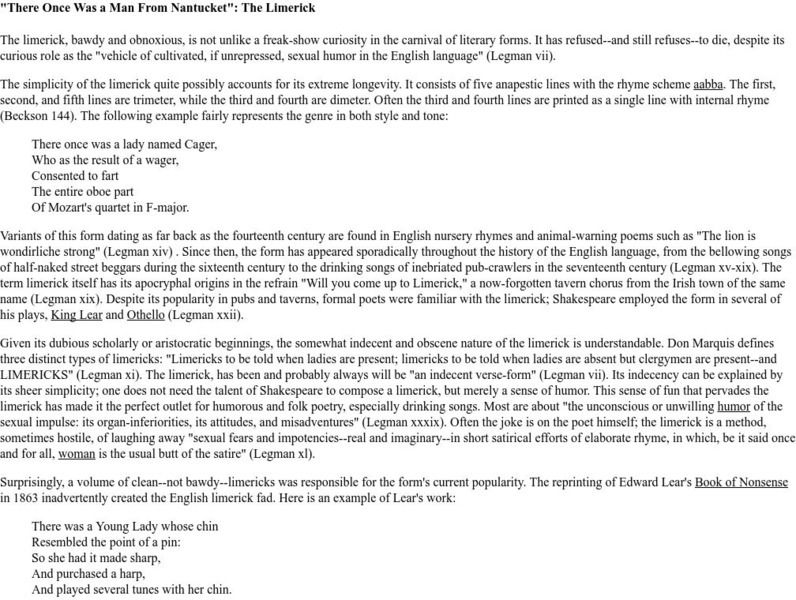
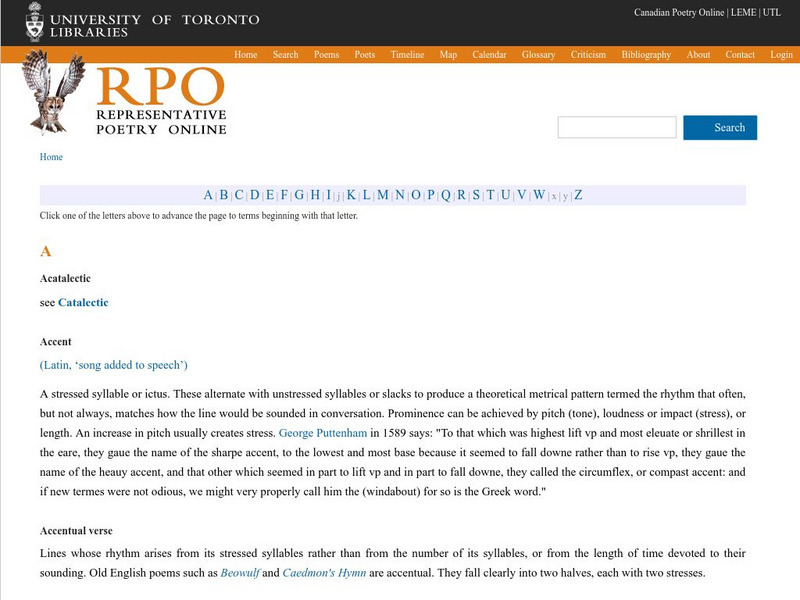



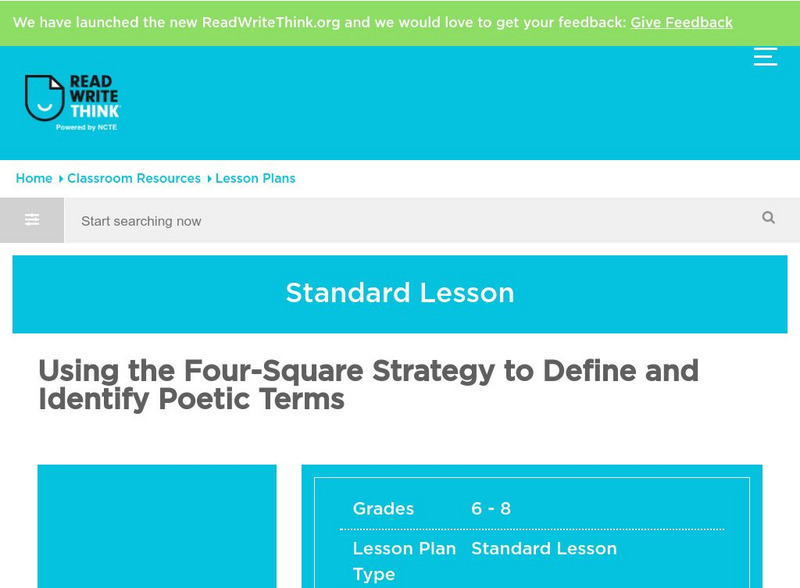

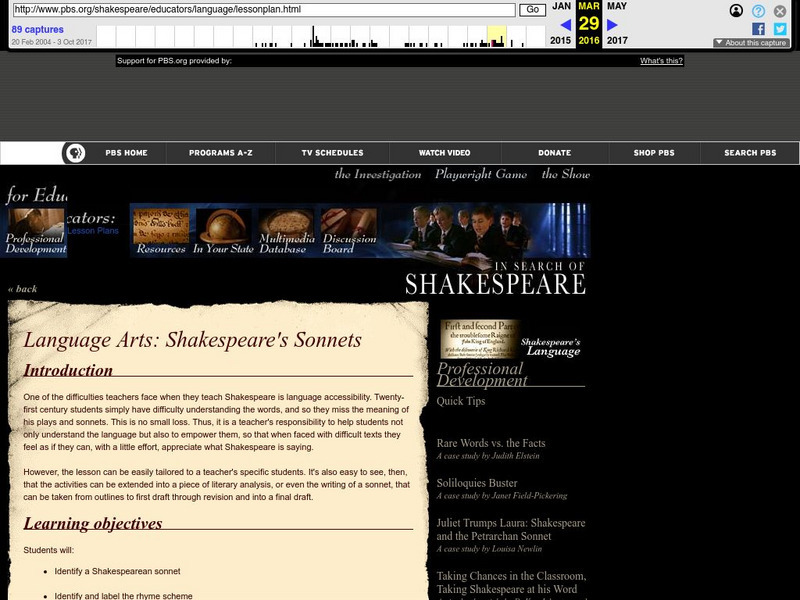
![Holt, Rinehart and Winston: Elements of Literature: Poetry You've Got Rhythm [Pdf] Unit Plan Holt, Rinehart and Winston: Elements of Literature: Poetry You've Got Rhythm [Pdf] Unit Plan](http://lessonplanet.com/content/resources/thumbnails/410060/large/bwluav9tywdpy2symdiwmduymc03otczlw41bjdpdy5qcgc.jpg?1589985147)


